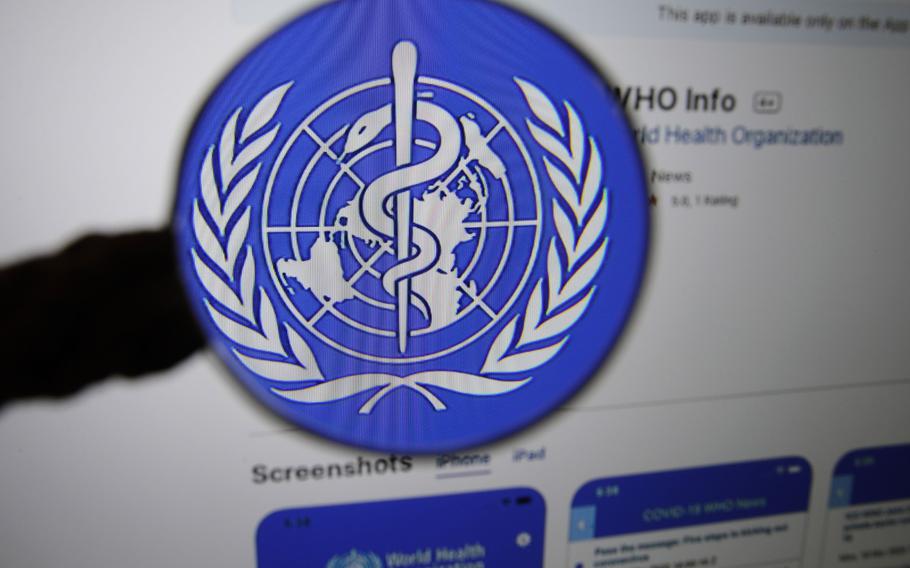
The logo for the World Health Organization Info application is displayed on a computer screen Bern, Switzerland, on March 31, 2020. (Stefan Wermuth/Bloomberg)
Stars and Stripes is making stories on the coronavirus pandemic available free of charge. See more stories here. Sign up for our daily coronavirus newsletter here. Please support our journalism with a subscription.
A team of scientists convened by the World Health Organization to better understand the origins of the coronavirus pandemic and possible future outbreaks has said a theory that the virus could have escaped from a laboratory needs "further investigations."
However, in a report released Thursday, the WHO-backed team said it had not received any new data that would allow it to better evaluate that theory.
Members of the group from Brazil, China and Russia objected to the calls for further investigation into the "lab leak" theory.
The report also said that available data suggests SARS-CoV-2 had a zoonotic origin, which means it spread between animals in a natural setting, but that neither the animal that infected humans nor the place where this infection occurred could be identified.
"At this point, the strongest evidence is still around zoonotic transmission," said Marietjie Venter, chair of the WHO team and a virologist at the University of Pretoria in South Africa. "However, the precursor viruses that have been identified in bats are definitely not close enough to be the virus that spilled over into humans."
The report was written by the Scientific Advisory Group for the Origins of Novel Pathogens (SAGO), a body made up of experts from the United States, China and 25 other nations that first came together last year after widespread criticism of a joint WHO-China investigation into the coronavirus' origins.
WHO officials emphasized that the report contains only the preliminary findings of the group, which was created to advise the global health body's secretariat. SAGO did not undertake its own studies, but instead reviewed existing research.
The team is designed not only to help investigate the origins of the coronavirus but also to set up a framework for understanding the origins of future outbreaks. Its work is expected to last for years, WHO officials said.
"It is just the start," Maria Van Kerkhove, a World Health Organization epidemiologist on the SAGO secretariat, told reporters before the release of the report. "They've made some good progress. They've clearly outlined that there's more work to be done."
Even so, the report may breathe life into a debate that has never come to a firm conclusion: Where did the coronavirus pandemic come from? While many scientists have favored a theory of zoonotic spread, the lab-leak theory has gained prominent support from some experts, including some U.S. officials.
Beijing has fiercely rejected the idea that the coronavirus could have escaped from the Wuhan Institute of Virology or another research institute studying coronaviruses in the Chinese city where COVID-19 was first recorded in late 2019.
In its place, Chinese officials promoted wild theories without scientific backing, including that the virus originated in the United States or was imported to China on frozen fish.
The SAGO report aimed to evaluate pandemic origins from a scientific stance, Van Kerkhove said. "We are under no illusions that we can keep all of the politics out, but we will do our damnedest to keep focused on what needs to be done here."
The preliminary SAGO report was released more than a year after a joint WHO-China team traveled to Wuhan and released its own report that ruled out the lab-leak theory as "extremely unlikely," while suggesting that the idea the virus was carried by frozen food needed further investigation.
The WHO-China report concluded that zoonotic spread was the likeliest scenario for the origin of the virus, but failed to find evidence for how it was spread to humans.
That report was widely criticized after being released in March 2021, with WHO Director General Tedros Adhanom Ghebreyesus suggesting that the report did not conduct an "extensive enough" assessment of the lab-leak theory and voicing frustration with the low level of access given to the mission by Chinese officials.
One of the researchers on the joint team, Danish food scientist Peter Ben Embarek, later told interviewers that Chinese researchers on the team had pushed back against including the lab-leak theory in the report at all.
While SAGO was convened to address some of the criticism of the WHO-China report, it also was able to evaluate some new evidence, including data on blood samples from 40,000 Chinese donors in Wuhan between September and December 2019.
According to the report, more than 200 of these samples initially tested positive for antibodies to SARS-CoV-2, but these were later found to be false positives. SAGO requested further information on the data and methods used to analyze the samples.
The new report suffers from some of the same limitations as the joint WHO-China report — including that Chinese officials cannot be compelled to cooperate with any investigation.
According to the SAGO report, Tedros sent letters to Chinese Premier Li Keqiang and Health Minister Ma Xiaowei on Feb. 14 and Feb. 21, respectively, requesting information on a variety of factors, including the "laboratory hypotheses."
It is not clear whether Tedros received a reply. Tarik Jasarevic, a spokesperson for the WHO, said the body doesn't share correspondence it has with member states.
Venter, the SAGO chair, said Chinese officials had cooperated with the team, sending experts to present and discuss new findings.
"We recognize that they've done a huge amount of work and they have addressed several of the questions" raised in the initial WHO-China report, Venter said.
However, SAGO found that much had not been addressed. Venter identified the Huanan Seafood Market in Wuhan as one location that needed more study. "We recognize that the market … may have been an amplification event of the early outbreak, but it's not clear where all those animals came from. We need to follow up on that," she said.